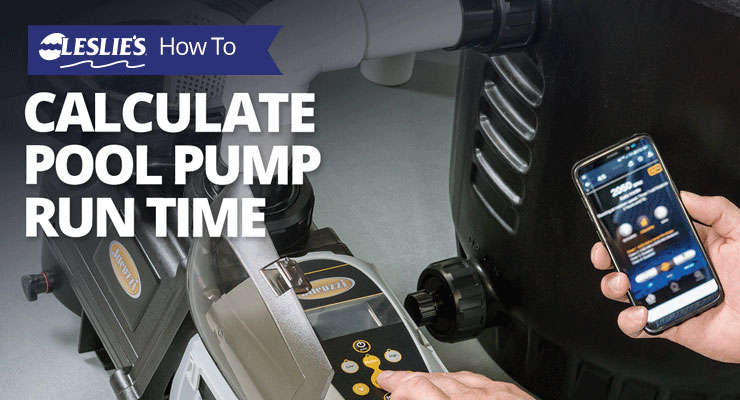
How to Calculate Pool Pump Run Time
If you are a pool owner, you surely have a pool filter pump. But knowing how long to run a pool pump and when to run it can be a bit puzzling. Did you know that your pool filter pump system is the second highest energy consumer in your home during the summer, with air conditioning units being the number one? Knowing how to calculate and set your pool pump run time is important to optimize its effectiveness.
Let’s walk through a few common questions and then break down the calculation behind finding the ideal pool filter pump run time for your swimming pool. We will show you both the standard calculation and a simple calculation.
What Does the Pool Filter Pump Do?

To understand how much run time you need, it’s important to know exactly what your filter pump does for your pool. The pool pump is the heart of your pool filtration system. It circulates water from the pool and returns it back, distributing pool chemicals and filtering your water. It is recommended that you “turnover” or circulate all of your pool water through the pool filter at least once throughout the day. This will ensure that the chemicals are evenly distributed and your water stays clean and clear. If you don’t circulate the water, you run the risk of algae growth and water balance or clarity issues. This may lead to water that is unsafe for swimmers.
How Many Gallons of Water Are in My Pool?
Before you can determine how long the pump should run, it’s important to understand how many gallons of water are in your pool. To find your pool’s volume, use one of these easy calculations. If you don’t want to calculate the pool volume, take a quick look at the table in our post on how to calculate pool volume.
Square and rectangle pools with single depth:
Length x Width x Depth x 7.5 = Approximate Volume (Gallons)

Square and rectangle pools with variable depths:
Length x Width x Average Depth x 7.5 = Approximate Volume (Gallons)
Average Depth: If the pool has a shallow end and a deep end, add the two depths together and divide by 2.
Example: The shallow end is 3' deep and the deep end is 8'. Using the Average Depth formula: (3+8)÷2=5.5' Average Depth.
Round pools:
3.14 x Radius x Radius x Average Depth x 7.5 = Volume (Gallons)
The Radius equals the diameter divided by 2. (Example: A 16' diameter divided by 2 = 8' radius.)
Note: Most round pools have a single depth.
Oval pools:
3.14 x Length x Width x .25 x Average Depth x 7.5 = Approximate Volume (Gallons)
Kidney-shaped pools:
(A + B) x Length x 0.45 x Average Depth x 7.5 = Approximate Volume (Gallons)
Note: “A” and “B” measurements are the two widest points of the kidney shape.
Irregular shapes or free-form pools:
Longest Length x Widest Width x Average Depth x 5.9 = Approximate Volume (Gallons)

What is the Turnover Rate?
Now that we have the pool volume in gallons, we can calculate the turnover rate. Turnover rate is the measure of which all the water in your pool can “turn over,” or pass through, the pump and filter. Most pool owners aim for an 8–10 hour turnover, with the rate measured in gallons per hour (GPH).
Total Pool Volume in Gallons ÷ 8 Hours = Maximum GPH Turnover Rate
Total Pool Volume in Gallons ÷ 10 = Maximum GPH Turnover Rate
What is the Pump Flow Rate?
The water flow, or flow rate, for most pool filter pumps is measured in gallons per minute (GPM), versus gallons per hour (GPH). As the measurement names imply, flow rate is an indicator of how much water can flow through the pump in a given span of time. Depending on whether you’re needing GPH or GPM, they’re easy to convert:
GPH ÷ 60 = GPM
GPM X 60 = GPH

Let’s Do Some Math!
Now that we know the flow rating and pool volume, we can calculate the pool pump run time. The math is simple. For this example, let's say you have a 20,000 gallon pool and the pool pump has a GPM rating of 40. Grab your calculator to figure this out:
40 (GPM) X 60 (minutes per hour) = 2400 gallons per hour
20,000 (gallons) / 2400 (gallons per hour) = 8.3 hours
In this case, the ideal pool filter pump run time is 8.3 hours per day for one circulation or water turnover.
A Simpler Calculation
Single speed pumps
Here is a simple rule of thumb for pools with single speed pumps during the swim season when the temperatures and swimmer volume are both high:
Run the circulation system one (1) hour for every 10°F of air temperature.
Example: If it is 100°F, the pump should run 10 hours a day minimum. Of course, if the pool is full of algae or a major weather event has occurred, the pump may need to run for 24 hours until the water clears.
Variable speed pumps
Variable speed pool pumps should run longer, based upon the operating speed. Most pool owners run their variable speed pump for 12 hours per day (3-4 hours on high speed for the pool cleaning system and 8-9 hours on low speed for filtration). Keep in mind that certain features — Salt Water Chlorine Generators and heaters — may not operate properly or even turn on if the filter pump is running on low speed.
Any Further Questions?
If you have any further questions about pool pumps, we're here to help! Stop by your local Leslie’s to speak with one of our friendly pool experts.